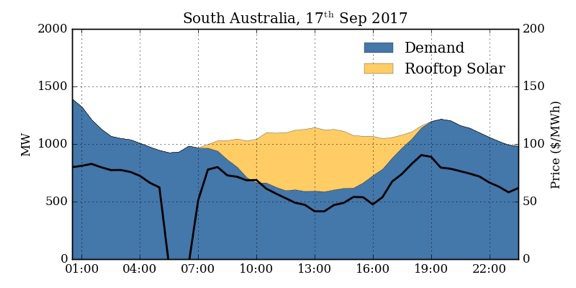What other heavily subsidized industry brags about its ability to provide a product for one quarter of the time it’s needed? Vale sunny-day-solar!
Pick a day, an hour, and what are the chances solar will be there for you? A lot less than one in four, because last Monday’s peak in South Australia was an all time record. Every day in the last year was worse.
And so much for cheap… the price when solar power peaked was still close to $50/MWh. Compare that to most of the years of the national electricity market operating when average prices were $30/Mwh.
The price dip at 6am (the black-line bottomless gully), has nothing to do with solar, but was caused by wind power. Far from being useful, essential, or productive, solar and wind power are playing havoc with a normal market, destroying the chance for cheap, reliable energy to find a place. As long as we force the market to accept this non-dispatchable supply, we are actively punishing reliable power. What investor in reliable energy would look at this and head to South Australia?”

Giles Parkinson was excited at Reneweconomy: Rooftop solar provides 48% of South Australia power, pushing grid demand to a record low.
South Australia’s level of minimum demand hit a new record low this weekend – barely a week after the previous benchmark was set – with a fall to just 587MW on Sunday afternoon.
We can see what a wild spike this particular lunchtime peak was:
The record eclipsed the previous mark by nearly 200MW – with AEMO data showing minimum demand at 1.30pm of exactly 587.8MW, compared with the previous low mark of 786.42MW posted last Sunday. (See graph above courtesy of Melbourne’s Climate and Energy College).
That is a phenomenal share of 47.8 per cent of the state’s electricity demand being met by rooftop solar (compares with 36 per cent in the previous record last week) and is clearly a record for South Australia, and for that matter in any large grid anywhere in the world.
Parkinson seems to think a slight dip in exorbitantly high prices is a good thing?
The impact of rooftop solar is being felt in prices – look at the black line that shows prices fall as rooftop solar accounts for a sizeable share of demand during the day.
Yes, let’s look at the black-line price “dip” (but don’t compare it with the long term price for electricity when renewables were a smaller part of the grid.)
The South Australians are in deep:
South Australia is the first region where rooftop solar PV has caused a shift in minimum demand from night time to the middle of the day (most states still have electric hot water being switched on at night, when it would make sense to use the “solar sponge” as Queensland has suggested).
We could reprogram all the hot water heaters to automatically switch on in the middle of the day. Bravo. When it’s not so record-breaking-sunny (which is nearly every other day), we’ll a/ pay more for hot water, or b/ have cold showers? We could use the hot water tanks to store solar energy — but isn’t that what we make solar-hot-water-heaters for, and aren’t they more efficient at it? Why not heat the water direct instead of using PV cells to generate electricity, then use the electricity to heat the water? Is this the big advance Parkinson is excited about?
How “good” is a market price of minus $44?
Note, also, the negative price of minus $44/MWh at 6am when there was abundant wind and a constraint on the connector with Victoria.
The sign of a screwed market. Let me build a plant and pay you to take my electricity…. How does that work as a free market, nay, socialist plan — just fine. Would you like nationalized coal with that? The only company that can afford to run the cheapest generator in the market is one with shareholders who are forced to pay and never ask for a dividend.
It also questions the need for old fashioned concepts such as “baseload”, which would struggle to find a niche in a market dominated by wind and solar, where mostly “dispatchable” and flexible generation is needed to fill in the gaps. Wind energy is already producing more than 100 per cent of local demand at certain times.
Baseload is old fashioned in the same sense that cooking dinner at 6-9pm is. Ninety nine percent of Australia is still living the baseload dream.
PS: There are still subsidies for Solar Hot water systems in Australia, and according to wiki, even after the subsidy it takes nearly 7 years to “pay back” the solar hot water system even in the sunniest country on Earth. (See “costs”.)